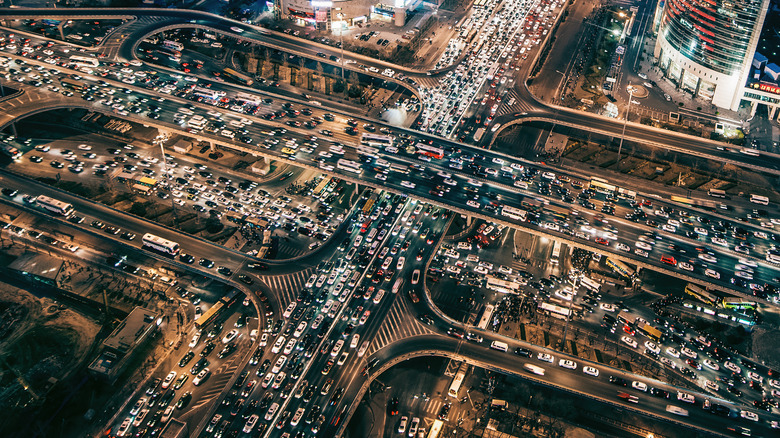Here's Why Traffic Jams Can Happen For No Reason
The rage is real, oh yes. For anyone who's ever been wedged in the center of a mass of packed motorway metal for hours on end, few things can be as frustrating. The sense of helplessness, the futility of car-bound wrath, the time of your one, precious life draining away like the gas in your tank — rage and exhaustion are the least of reasonable responses.
This is especially true if you're gazing down the road, looking for a reason — anything at all — that can explain the traffic jam. A big, multicar pileup with ambulances and police? Understandable. Some construction funneling all the cars into one lane? Exasperating, but at least it makes sense. But sometimes the jam just — whoosh! — vanishes and cars resume normal speed. What in the world? What happened? What was the cause? Damnation and hell upon the earth and all of its drivers!
Ahem. The reason for such "phantom traffic jams," as Vox calls them, will definitely not improve your road rage: faulty human judgment. Yes, at its core it's that simple. Phantom traffic jams start with one car, and one car only, and cascade from there. As a helpful, illustrated TED-Ed video on YouTube shows, one driver in close traffic gets nervous about hitting the person in front of them, taps the breaks, the person behind does the same, and before you know it, you've got a snake of clogged cars and flickering taillights for miles down the road.
A backward-moving wave of braking
A very handy, older video on YouTube from the Nagoya University, Japan (above) shows precisely how phantom traffic jams work. Researchers asked 22 drivers to drive around a simple, circular track — that's it. Drivers started off just fine, with each maintaining roughly equal distance between the cars in front of and behind them. But sooner rather than later, errors started to accumulate.
Like a backward-moving wave, one driver in the experiment got too close to the driver in front of them, tapped the brakes, and then the one behind did the same, and the next, and the next, etc. Looking at the video, the reverse ripple motion of cars getting too close to each other is very clear and easy to see and moves backward along the track from its origin point. And this experiment, it should be noted, happened on an exceedingly simple, single-lane, slow-moving track with no obstacles, no lane changes, and no real decision-making of any kind — not on a live multilane road with a thousand variables that drivers have to follow.
As Vox cites, such traffic jams are more likely to form when people move at fast speeds. At fast speeds people have less time to brake, and they wind up braking last second. And naturally, if the person in front of you brakes, you'll brake to avoid hitting them. Ultimately, overeager driving plus the contrary desire for safety equals an intolerable traffic nightmare for everyone.
Remedies and solutions
So what to do about all the dumb-dumbs clogging the road? Well, there are some practical measures that you can take to lessen the effects of phantom traffic jams. Stopping them altogether, though, would take every single driver working together as one flawless unit — so that's not going to happen. Of course, as Science says, self-driving cars can monitor and maintain the precise same distance between themselves and other cars on the road and smoothly file onward to their destinations. Easy.
For those of us not sitting in self-driving cars, the same rule applies: maintain distance. As a discussion on NPR describes, drivers can reduce the likelihood that phantom traffic jams will form by paying attention not only to the car in front of them but to the car behind them. Basically, you want to maintain a distance halfway between both cars, so neither you nor the car behind you gets caught too off-guard. This would also help prevent tailgating, which is a huge reason why folks have to brake suddenly. From there, there's some mathematical wizardry and talk of "chaotic systems" and "positive feedback" that don't matter to those of us just wanting to get home.
Additionally, Vox says that if drivers are paying attention and not just zoning out or having a little carpool karaoke time with Taylor Swift's latest album, they can anticipate when jams are likely to occur. Look further down the road (sooner) and lay off the gas.

